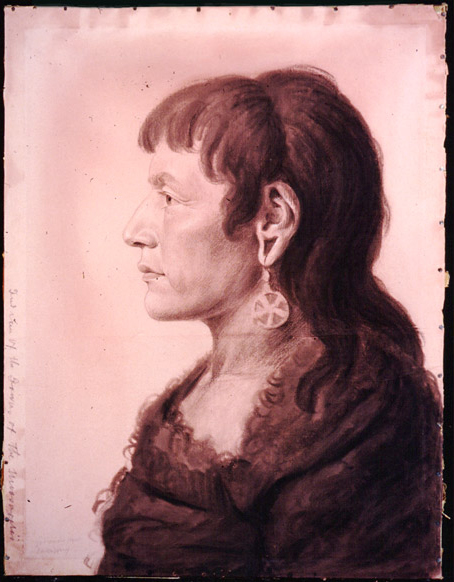Sheheke, also known as Big White, and one other come to the expedition’s camp at the Knife River Villages having missed yesterday’s council. Clark and eight men head up the river in search of a place to spend the winter. When they return, the men are given a dram and dancing with the locals commences.
Sheheke—”Big White” (1807)[1]Lewis commissioned a portrait of Sheheke and one of his wife, Yellow Corn, for his projected edition of the journals, but he did not write the book after all, and the portraits were not included in … Continue reading
by Charles B. J. F. de Saint Mémin (1770–1852)
Chalk and charcoal on pink paper on canvas, 22-3/8 by 17 inches. #1860.95. Courtesy Elizabeth DeMilt Fund, Collection of the New-York Historical Society Museum.
Sheheke, Big White
Two Chiefs came to have Some talk one the princapal of the lower Village the other the one who thought himself the principal mane, & requested to hear Some of the Speech that was Delivered yesterday they were gratified, and we put the medal on the neck of the Big White to whome we had Sent Clothes yesterday & a flag, those men did not return from hunting in time to join the Counell, they were well pleased (2d of those is a Chien [Cheyenne])
—William Clark
Searching for Winter Quarters
went up the river as far as the 1st Island about 7 miles to See if a Situation Could be got on it for our Winter quarters, found the wood on the Isd. as also on the pt. above So Distant from the water that, I did not think that we Could get a good wintering ground there, and as all the white men here informed us that wood was Sceres, as well as game above, we Deturmined to drop down a fiew miles
—William Clark
Celestial Observations
Wound up the Chronometer, and observed equal Altitudes of the
with Sextant.
—Meriwether Lewis
Evening Dancing
on my return found maney Inds. at our Camp, gave the party a dram, they Danced as is verry Comn. in the evening which pleased the Savages much.
—William Clark
Weather Diary
Thermot. at rise
Weather Wind at rise
thermotr. at 4 P.M. Weather Wind at 4 oC P.M. 32 fair S W 52 fair S W. Capt. Clark visited the island above to look out a place for winter encampment, but did not succeed
—Meriwether Lewis[2]To assist the reader, the editor of this web page has omitted the “day of the month” column and spelled out some abbreviations.
Knife River Indian Villages National Historic Site is a High Potential Historic Site along the Lewis and Clark National Historic Trail managed by the U.S. National Park Service. A unit of the National Park System, the site is located at 564 County Road 37, one-half mile north of Stanton, North Dakota. It has exhibits, trails, and a visitor center.
Notes
| ↑1 | Lewis commissioned a portrait of Sheheke and one of his wife, Yellow Corn, for his projected edition of the journals, but he did not write the book after all, and the portraits were not included in the 1814 condensation of the captains’ journals, edited by Nicholas Biddle. Roy E. Appleman, Lewis & Clark: Historic Places Associated with Their Transcontinental Exploration (1804–06) (Washington, D.C.: United States Department of the Interior, National Park Service, 1975), 377n. The artist himself erroneously labeled Sheheke’s portrait, at the left edge, Indien des Iowas du Missoury—“Indian of the Iowas of the Missouri.” Ellen G. Miles, Saint-Memin and the Neoclassical Profile Portrait in America (Washington, D.C.: Smithsonian Institution Press, 1994), 435–36. |
|---|---|
| ↑2 | To assist the reader, the editor of this web page has omitted the “day of the month” column and spelled out some abbreviations. |
Experience the Lewis and Clark Trail
The Lewis and Clark Trail Experience—our sister site at lewisandclark.travel—connects the world to people and places on the Lewis and Clark Trail.
Discover More
- The Lewis and Clark Expedition: Day by Day by Gary E. Moulton (University of Nebraska Press, 2018). The story in prose, 14 May 1804–23 September 1806.
- The Lewis and Clark Journals: An American Epic of Discovery (abridged) by Gary E. Moulton (University of Nebraska Press, 2003). Selected journal excerpts, 14 May 1804–23 September 1806.
- The Lewis and Clark Journals. by Gary E. Moulton (University of Nebraska Press, 1983–2001). The complete story in 13 volumes.




